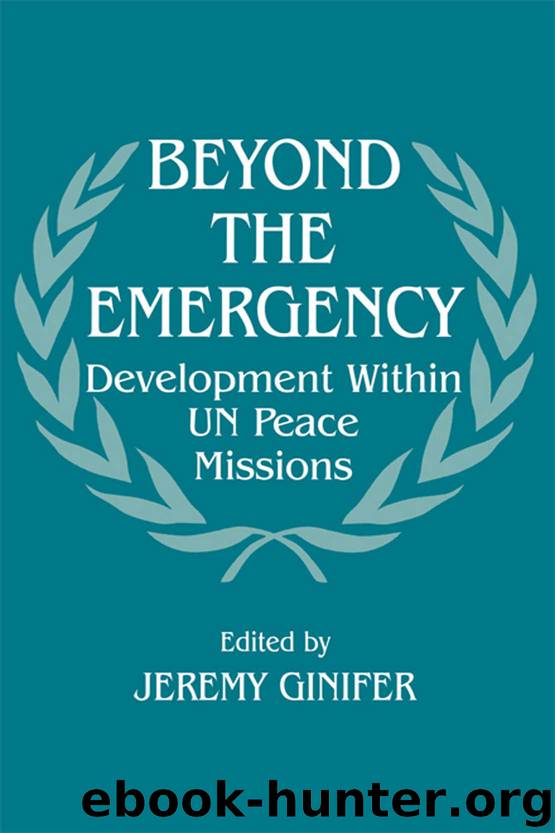Beyond the Emergency by Ginifer Jeremy

Author:Ginifer, Jeremy.
Language: eng
Format: epub
Publisher: Taylor & Francis Ltd
The Somalia Mandate
In mid 1992 Somalia was facing the dislocations resulting from civil war – population displacement, destruction of infrastructure and the control of food by armed combatants – and a severe drought that led to famine of frightening proportions. The establishment of UNOSOM I, followed by the deployment of UNITAF in late 1992, were responses of the international community to aid the provision of assistance to the Somali people through UN agencies and international non-governmental organizations (NGOs).
As UNITAF was rapidly succeeding in overcoming starvation, the UN resumed its mediation efforts to bring about a political settlement to the civil war, because:
without national reconciliation, involving the establishment of viable political structures and the disarmament and demobilization of the factional militias and armed irregulars, all the progress towards ending hunger would inevitably remain precarious and economic recovery would remain largely impossible.2
It should be noted that the mission was decided upon when the thinking or mood internationally was imbued with:
a palpable optimism that the [Security] Council and the world body in general would at last be able to fulfil the promise of the Charter – ‘to save succeeding generations from the scourge of war’.3
UNOSOM II was therefore established with a broad mandate, which included: political reconciliation; the building of political and administrative structures; disarmament and demobilization of fighters; enforcement of the arms embargo from within Somalia; the re-establishment of the Somali police force and justice system; the return of refugees and internally-displaced persons; de-mining; and rehabilitation and reconstruction.4 In short, the mission was tasked to assist the Somalis in their reconciliation and peacebuilding efforts. Indeed, the Permanent Representative of the United States was quoted as describing UNOSOM II as:
an unprecedented enterprise aimed at nothing less than the restoration of an entire country as a proud, functioning and viable member of the community of nations.5
The Security Council (SC) adopted resolution 814 (1993), establishing UNOSOM II, on 26 March 1993. However, it made no specific references to the issues being negotiated and agreed upon by the Somali leaders concurrently meeting in Addis Ababa. The Somali agreement was signed one day after the adoption of the SC resolution. The UN tasks envisaged by the SC and by the Somali political leaders did overlap in general terms but, since there were no close consultations between them, differences in the interpretation of how these tasks were to be fulfilled arose during the implementation period, and this led to the difficulties faced by UNOSOM II later on.
However, it should have been noted at the outset that from the time of its political independence from the British and Italian colonial powers in 1960, and through the periods of the parliamentary system in the 1960s and military government in the 1970s and the 1980s, Somalia has not been able to develop a national socio-political system capable of overcoming the deep divisions caused by the traditional clan form of social organization. The increasing dominance of the Marehan/Darod clan in the military during the Mohamed Siad Barre period; the suppression of the
Download
This site does not store any files on its server. We only index and link to content provided by other sites. Please contact the content providers to delete copyright contents if any and email us, we'll remove relevant links or contents immediately.
International Integration of the Brazilian Economy by Elias C. Grivoyannis(57339)
The Art of Coaching by Elena Aguilar(50039)
Flexible Working by Dale Gemma;(22951)
How to Stop Living Paycheck to Paycheck by Avery Breyer(19216)
The Acquirer's Multiple: How the Billionaire Contrarians of Deep Value Beat the Market by Tobias Carlisle(11678)
The Radium Girls by Kate Moore(10910)
Thinking, Fast and Slow by Kahneman Daniel(10594)
The Art of Thinking Clearly by Rolf Dobelli(8850)
Hit Refresh by Satya Nadella(8340)
The Compound Effect by Darren Hardy(7565)
Atomic Habits: Tiny Changes, Remarkable Results by James Clear(7221)
Turbulence by E. J. Noyes(7044)
Tools of Titans by Timothy Ferriss(6952)
How to Be a Bawse: A Guide to Conquering Life by Lilly Singh(6695)
Change Your Questions, Change Your Life by Marilee Adams(6647)
Nudge - Improving Decisions about Health, Wealth, and Happiness by Thaler Sunstein(6636)
Win Bigly by Scott Adams(6319)
The Black Swan by Nassim Nicholas Taleb(6195)
A Court of Wings and Ruin by Sarah J. Maas(6093)
